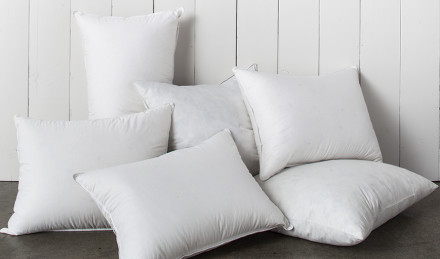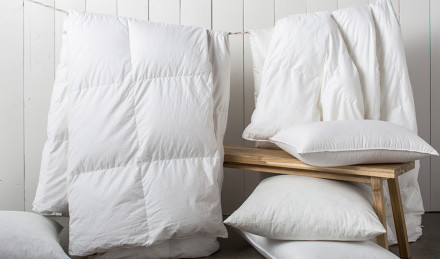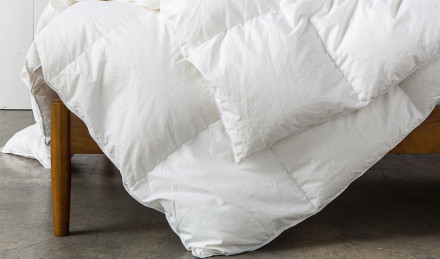Down Duvet Inserts give so much and ask so little in return. They’re lofty and warm while requiring very little maintenance. Because protecting them is pretty simple: Keep your pillows in pilllowcases and duvet inserts in duvet covers. These shield your bedding from dirt, spills and – most importantly – the oils in our skin.
As long as you follow those rules, you’ll only have to wash them once every season or so. While you could take them to get professionally cleaned, our all natural down and hypoallergenic down alternative filling are machine washable. It’s actually the cover material that makes a duvet dry clean only.* So here’s our cheat sheet on how to properly clean your bedding basics at home… *Our mattress toppers are dry clean only.

Spot-Treating
You can spot-treat the way you would with most laundry stains. Pull the cover away from the filling, dampen the area you want to treat, and rub in a small amount of detergent (see the next step for what kind) until it begins to foam. Let it sit overnight for extra potency. If you’re not washing the entire duvet insert, simply rinse that section until the suds are completely gone and let it fully dry before using again. You’ll want to first test the treatment in an inconspicuous area to make sure it doesn’t leave a ring.

Spot-Treating
You can spot-treat the way you would with most laundry stains. Pull the cover away from the filling, dampen the area you want to treat, and rub in a small amount of detergent (see the next step for what kind) until it begins to foam. Let it sit overnight for extra potency. If you’re not washing the entire duvet insert, simply rinse that section until the suds are completely gone and let it fully dry before using again. You’ll want to first test the treatment in an inconspicuous area to make sure it doesn’t leave a ring.

Machine Washing
Load your duvet insert (and nothing else) into an XL front-loading washing machine (if the machine’s too small, the duvet insert can get tangled and damaged, plus the weight of a wet comforter can knock top-loaders off balance). Add about a third the amount of detergent you’d usually use for a load that size — too much soap is bad for the filling and will take forever to rinse out, so err on the side of caution — and wash on the delicate cycle. Use cool water and a Laundry Detergent either specifically made for down or a mild, enzyme-free, all-natural variety. Run the rinse cycle twice to remove all the soap.
Machine Washing
Load your duvet insert (and nothing else) into an XL front-loading washing machine (if the machine’s too small, the duvet insert can get tangled and damaged, plus the weight of a wet comforter can knock top-loaders off balance). Add about a third the amount of detergent you’d usually use for a load that size — too much soap is bad for the filling and will take forever to rinse out, so err on the side of caution — and wash on the delicate cycle. Use cool water and a Laundry Detergent either specifically made for down or a mild, enzyme-free, all-natural variety. Run the rinse cycle twice to remove all the soap.

Drying
Tumble-dry your duvet insert in an industrial dryer on the lowest setting. Add a few Wool Dryer Balls or clean tennis balls to help fluff and keep the down or down alternative filling separated. Take the duvet insert out of the dryer after 20 to 30 minutes to check the temperature — if the duvet insert is hot to the touch, it’s too warm. Remove the duvet insert every half hour to break up clumps and let it cool. Have patience, because this is going to take a while. Depending on the size of your duvet insert, it may take up to five or six hours.
It’s very important to make sure the filling dries completely before you put the duvet insert back on your bed or in its cover, otherwise it can begin to grow mold. Hold the duvet insert against a light and examine for clumps — if you see any, that means it’s not yet dry. You can hang the duvet insert or lay it on a flat surface outside or in a well-ventilated room to allow for it to finish drying. Once your duvet insert is clean and dry, you can place it back in its pillowcase or duvet cover.

Drying
Tumble-dry your duvet insert in an industrial dryer on the lowest setting. Add a few Wool Dryer Balls or clean tennis balls to help fluff and keep the down or down alternative filling separated. Take the duvet insert out of the dryer after 20 to 30 minutes to check the temperature — if the duvet insert is hot to the touch, it’s too warm. Remove the duvet insert every half hour to break up clumps and let it cool. Have patience, because this is going to take a while. Depending on the size of your duvet insert, it may take up to five or six hours.
It’s very important to make sure the filling dries completely before you put the duvet insert back on your bed or in its cover, otherwise it can begin to grow mold. Hold the duvet insert against a light and examine for clumps — if you see any, that means it’s not yet dry. You can hang the duvet insert or lay it on a flat surface outside or in a well-ventilated room to allow for it to finish drying. Once your duvet insert is clean and dry, you can place it back in its pillowcase or duvet cover.

Storing
A good down blanket is incredibly breathable, so it’s totally reasonable to use one year-round. If you are going to store it for the summer, do so in a cotton bag or roll it into a cotton sheet. We recommend waiting a couple weeks, even up to a month, before packing a freshly washed duvet insert to ensure it’s completely dry. When you unpack it, just give it a few shakes to fluff the down, and you’ll be good to go.
Storing
A good down blanket is incredibly breathable, so it’s totally reasonable to use one year-round. If you are going to store it for the summer, do so in a cotton bag or roll it into a cotton sheet. We recommend waiting a couple weeks, even up to a month, before packing a freshly washed duvet insert to ensure it’s completely dry. When you unpack it, just give it a few shakes to fluff the down, and you’ll be good to go.




